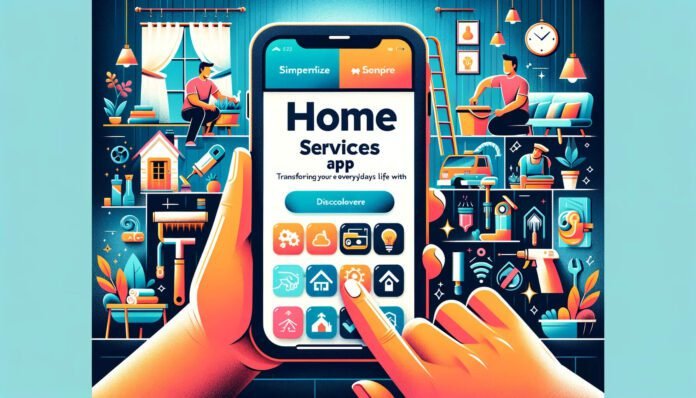Last Updated on July 19, 2024 by Asfa Rasheed
Table of Contents
Introduction to Home Services Apps
Welcome to the transformative world of home services apps, where the convenience of modern technology meets the everyday needs of homeowners and renters alike. In this section, we embark on a journey to explore the fundamental shift in how we approach household tasks and maintenance through the lens of innovative mobile applications.
The Growing Demand for Home Services Apps
The growing demand for home services apps can be attributed to their unparalleled convenience, time-saving features, and the provision of a wide range of services. In today’s fast-paced world, people are increasingly seeking solutions that streamline their daily tasks and chores. Home services apps offer a convenient way for users to access various services, from house cleaning and repairs to pet care and landscaping, all from the comfort of their smartphones. This combination of convenience, time-saving benefits, and service diversity has fueled the exponential growth of the home services app market, making them indispensable tools for modern living.
- Convenience: Home services apps provide users with a convenient way to access a variety of services from their smartphones or tablets, eliminating the need for traditional methods of finding and booking service providers.
- Time-saving: By enabling users to quickly browse and book services on-demand, home services apps save valuable time that would otherwise be spent researching, contacting, and coordinating with individual service providers.
- Wide range of services: These apps offer a comprehensive range of services, ranging from household cleaning and maintenance to specialized tasks like plumbing, electrical work, and even personal grooming services, catering to the diverse needs and preferences of users.
What is a Home Services App? Why create one?
- Definition: A home services app is a digital platform designed to connect users with a wide range of household service providers such as cleaners, handymen, electricians, plumbers, and more. These apps streamline the process of finding, booking, and paying for home-related services through a user-friendly interface accessible via mobile devices.
- Purpose: The creation of a home services app addresses the growing need for convenience and efficiency in managing household tasks and maintenance. By centralizing access to various service providers, these apps simplify the process for users, saving them time and effort in sourcing and coordinating services. Additionally, home service apps provide an opportunity for service providers to expand their reach and clientele by leveraging digital platforms to showcase their offerings and connect with potential customers. Overall, the creation of a home services app aims to enhance the user experience, optimize service delivery, and capitalize on the growing demand for on-demand services in the modern digital age.
Key Features of Home Services Apps
- User-friendly interface:
Home services apps prioritize ease of use with intuitive interfaces, allowing users to navigate effortlessly through the app to find and book the services they need. Clear categorization, search functionality, and streamlined booking processes enhance the overall user experience. - Secure payment options:
To instill trust and confidence among users, home services apps integrate secure payment gateways that enable seamless and safe transactions. Multiple payment methods, such as credit/debit cards, digital wallets, and in-app payment systems, are typically supported to accommodate user preferences. - Real-time tracking:
Providing transparency and peace of mind, home service apps often feature real-time tracking functionalities that allow users to monitor the status and progress of their service requests. This feature enables users to stay informed about the arrival time of service providers and track their location during the service delivery process. - Ratings and reviews:
User feedback plays a crucial role in maintaining service quality and reputation within home services apps. By incorporating ratings and review systems, users can share their experiences and provide feedback on service providers, helping others make informed decisions. Additionally, service providers can use this feedback to continuously improve their services. - In-app chat support:
For seamless communication and assistance, home services apps offer in-app chat support features that allow users to directly communicate with service providers or customer support representatives. Whether it’s clarifying service details, resolving issues, or requesting additional information, in-app chat support facilitates prompt and efficient communication between users and service providers.
Types of Home Services App Development
- On-Demand Apps: On-demand home services apps connect users with service providers for immediate assistance, allowing users to request services as needed, typically with quick response times.
- Marketplace Apps: Marketplace home services apps act as platforms where users can browse and choose from a selection of service providers based on their preferences, reviews, and availability.
- Aggregator Apps: Aggregator home services apps aggregate service providers from various categories into a single platform, offering users a wide range of services to choose from within a unified interface.
How to Develop a Successful Home Services App
- Market research and analysis:
Begin by conducting comprehensive market research to understand the dynamics of the home services industry. Identify key trends, emerging technologies, competitor offerings, and customer preferences. Analyze market gaps and opportunities to inform your app development strategy. - Identifying target audience:
Define your target audience based on demographic factors such as age, location, income level, and lifestyle. Understand their specific needs, pain points, and preferences regarding home services. Tailor your app’s features, design, and marketing efforts to cater to the needs of your target audience effectively. - Creating a robust app architecture:
Develop a solid app architecture that ensures scalability, flexibility, and reliability. Design an intuitive user interface (UI) and seamless user experience (UX) that makes it easy for users to navigate the app, browse services, and book appointments. Implement a secure backend infrastructure to handle user data, payment transactions, and service provider management. - Integrating essential features:
Incorporate essential features that enhance the functionality and usability of your home services app. These features may include a user-friendly service booking system, secure payment gateways, real-time tracking of service providers, a ratings and reviews system, in-app chat support for communication, and push notifications for updates and reminders. - Testing and quality assurance:
Prioritize thorough testing and quality assurance processes to ensure that your app functions flawlessly across various devices and platforms. Conduct usability testing, performance testing, security testing, and compatibility testing to identify and address any bugs, glitches, or usability issues. Solicit feedback from beta testers and iterate on your app until it meets high-quality standards.
How Much Does It Cost to Create Home Services Apps
Determining the cost of creating home services apps can vary significantly depending on various factors such as the app’s complexity, features, development platform, design requirements, and the development team’s hourly rates. On average, however, developing a basic home services app can cost anywhere from $20,000 to $50,000.
For more advanced apps with additional features like real-time tracking, secure payment options, ratings and reviews systems, and in-app chat support, the cost can range from $50,000 to $150,000 or more. It’s essential to consider ongoing expenses such as maintenance, updates, and marketing when budgeting for app development. Working with an experienced app development team or agency can help provide a more accurate cost estimate based on your specific requirements and objectives.
Case Studies of Successful Home Services Apps
- Uber for Home Services:
Uber for Home Services, also known as Uber for X, revolutionized the on-demand service industry by applying the same model used for ride-hailing to various other services, including home services. By leveraging the Uber platform’s infrastructure and user base, startups like Handy and TaskRabbit emerged, offering services such as cleaning, repairs, and handyman tasks. These apps connect users with service providers seamlessly, providing transparency, convenience, and flexibility. Through efficient matching algorithms, real-time tracking, secure payments, and user ratings, Uber for Home Services apps have transformed the way people access and utilize home services.
- TaskRabbit:
TaskRabbit is a prominent example of a successful home services app that connects users with skilled taskers who can help with various household chores and errands. Founded in 2008, TaskRabbit gained traction by offering a wide range of services, including furniture assembly, home repairs, cleaning, and moving assistance. The app’s user-friendly interface, transparent pricing, and reliable taskers earned it a loyal customer base. TaskRabbit’s success lies in its ability to provide a seamless experience for both users and taskers, facilitated by features such as real-time messaging, secure payments, and a robust rating system.
- Handy:
Handy is another leading home services platform that has achieved significant success in the industry. Founded in 2012, Handy offers services such as cleaning, home repairs, furniture assembly, and plumbing. The app’s key features include easy booking, background-checked professionals, upfront pricing, and a satisfaction guarantee. Handy’s focus on quality service and customer satisfaction has helped it stand out in a competitive market. With millions of bookings completed and a growing network of service professionals, Handy has become a trusted choice for homeowners and renters seeking reliable home services.
Future Trends in Home Services App Development
- AI Integration for Personalized Services:
As technology continues to advance, AI integration is expected to play a significant role in the evolution of home services apps. AI-powered algorithms can analyze user behavior, preferences, and past interactions to provide personalized recommendations and tailored services. From suggesting customized cleaning schedules to predicting maintenance needs based on usage patterns, AI can enhance the overall user experience and efficiency of home service apps.
- Augmented Reality for Enhanced User Experience:
Augmented Reality (AR) technology holds immense potential for transforming the way users interact with home services apps. By overlaying digital information and virtual objects onto the physical environment, AR can provide users with immersive experiences, such as visualizing furniture placement before purchase or virtually trying out paint colors for home renovation projects. Integrating AR into home services apps can streamline decision-making processes, improve accuracy, and enhance user engagement.
- Expansion into Emerging Markets:
As the demand for home services continues to grow globally, there is significant potential for expansion into emerging markets. Rapid urbanization, increasing disposable incomes, and a rising tech-savvy population in emerging economies create opportunities for home services apps to penetrate new markets. By adapting their offerings to local preferences, languages, and cultural norms, home service apps can capitalize on untapped market segments and fuel further growth and innovation in the industry.
Conclusion
The future of home services app development holds exciting prospects, driven by advancements in technology and evolving consumer preferences. AI integration promises to revolutionize the industry by delivering personalized services tailored to individual needs, while Augmented Reality offers immersive user experiences that enhance decision-making and engagement.
Furthermore, the expansion into emerging markets presents vast opportunities for growth and innovation, as home services apps cater to the evolving needs of a global audience. As we embark on this journey of transformation, companies like Moon Technolabs stand at the forefront of home services app development, leveraging their expertise and innovation to shape the future of the industry and deliver exceptional solutions that enrich the lives of users worldwide.
















